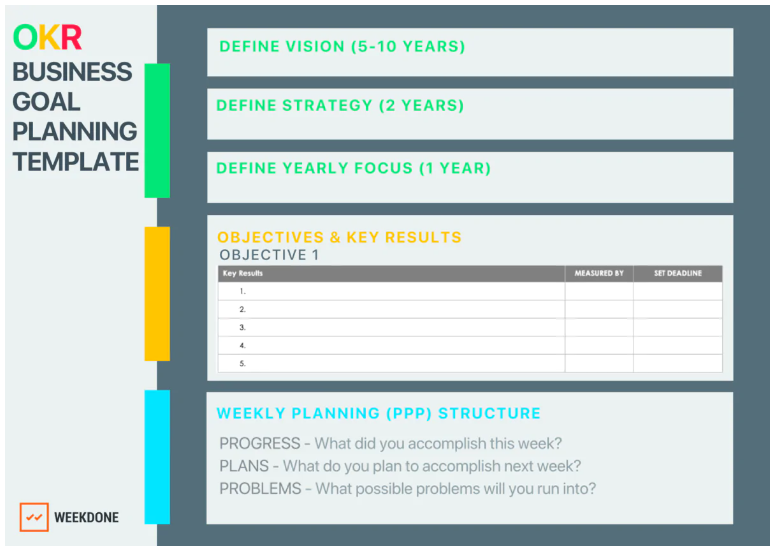“Business executives state that 56% of the time spent on strategic business planning is wasted.” Gartner
An enterprise strategist once said, “We spent days and hours on strategic business planning but it did not translate to strategic initiatives, it did not prepare us for disruption – it did nothing.” Does this sound familiar?
This may be the narrative many leaders face. It is not enough to create a strategy and allocate resources to execute them. It is important to prepare and have a strategic approach to business planning and include everyone in the company’s strategy.
To translate strategy and business plans into action many companies are now using the Objectives and Key Results (OKR) framework. They are implementing OKRs to set structured goals, drive performance, track progress, align everyone’s priorities toward achieving a common goal, and provide a roadmap to success.
How to create a business plan? One that is effective and delivers optimal outcomes. How to adopt the OKR framework to create business plans strategically? Is there a useful business plan template to get started? Read on to understand how to approach strategic planning and execution differently, set strategic objectives, align your goals, and achieve better results.
💡 When BMAT implemented OKRs they were able to realize their core value of making company goals transparent – so that everyone could be connected to the overall company strategy.

Step-by-Step Approach to Creating an Effective Business Plan
Strategic business planning for modern leaders involves creating a systematic, step-by-step approach to assess and revise mid-term and long-term strategies and goals. Traditional business plans typically involve documenting the business idea, company description, company structure, target market analysis, and financial projections.
Developing an efficient business plan goes beyond documentation, it focuses on the purpose, important challenges to address, critical improvements to make, and specific action plans to achieve long-term strategic objectives.
Consider these steps to effectively create a business plan that can keep up with the pace of business:
- Start with a strategy – Getting the strategy right is the first step in any planning process. Translating the long-term view of these strategies into what needs to be done is the next step. Break down long-term goals into short-term quarterly objectives and define outcome-based Key Results.
- Communicate the strategy – Once the business strategy is clearly defined, communicate the vision with the rest of the organization. This aligns progress toward the overarching goal, prevents misguided initiatives, and builds a connection with the company’s vision.
- Confirm the context and identify capabilities – Discuss and have other leaders share their aspirations about the current and future state of the company. Identify the capabilities and resources required to accomplish these aspirational objectives.
👉 At the ideation stage, sharing the most important priorities and getting feedback can build a meaningful connection between the work employees do and the company’s vision.
- Establish goals and objectives – Identify strategic priorities and create objectives for every business goal. Ensure that objectives are actionable, measurable, and accountable.
- Define measurable metrics – To measure the progress made toward achieving goals define and set measurable metrics. Setting quantifiable key results ensures you can assess how your goals are progressing.
- Create an action plan – Identify initiatives needed to achieve your objectives. It could be independent Initiatives that are not connected to any objective or targeted initiatives linked to a specific OKR
- Set a formalized check-in process – Whether it’s through weekly check-ins or quarterly reviews (aka retrospectives), regular check-ins are necessary to ensure focus is maintained on big-picture goals and that the progress is on track.
When creating a business plan keep in mind these pointers to ensure your strategic planning and execution are effective:
- Focus on outcomes, not outputs to drive Objectives and Key Results and the forward
- Monitor triggers and track the effectiveness of the strategic business plan
- Reassess strategic assumptions periodically
- Identify and halt underperforming projects and initiatives promptly
- Revisit, monitor, and measure progress to adapt strategies as business conditions change
- Document lessons learned and make adjustments in future business planning cycles
👉 Want to articulate your business goals clearly? Here’s a simple Business Plan Template – applicable to any business type and industry sector – to document and share your company’s mission statement, vision, and strategy.
Strategy and OKR Planning
When adopting the OKR approach, it is important to be clear about your strategy and business objectives. Start with asking big questions to formulate your vision, mission, and strategy. Create a strategy roadmap, share and discuss the strategy with other stakeholders, and finalize strategic priorities. Establish a cadence and timing for strategy planning and execution meetings.
👉 To plan OKRs more effectively and see positive business outcomes, there should be alignment between the team’s efforts and the company’s goals and vision. This step-by-step guide when planning OKRs could be useful.
Here’s an overview of how to translate strategy into OKRs and action plans:
- When creating the strategy, take inspiration from the company’s vision and mission – “What does the company aspire to be for it to be successful?”
- Identify the strategic goals – ”What should be or needs to be achieved this year?”
- Determine the quarterly objectives – “What needs to be achieved this quarter?”
- Define measurable key results – “What results are needed to make progress toward the objective?”
- Create strategic initiatives – “What projects need to be undertaken to achieve the desired outcomes to drive the Objectives and Key Results?”
💡 Find out how to translate OKRs and strategy into an actionable business plan and keep pace with the speed of business. Connect OKRs, business planning, and strategy execution to get optimal business outcomes.
Better Business Planning with OKRs
Using a framework that aligns team goals with the company vision is one sure way to see long-term business success. Try OKR software to connect vision, mission, goals, and activities across your organization.
Questions to Approach Business Planning
Business planning begins with understanding what your strategy should be, the direction you need to take, the areas you need to improve, and the resources you need to accomplish your goals.
Ask the Big Strategic Questions
Successful business leaders have a clear vision and articulate it clearly across the company. Most importantly, they translate strategy into business plans. The essence of a good business planning process is defining the company’s direction and making clear how individual contribution contributes to achieving overarching company goals.
Big-Picture Questions to Set Company Objectives
What are Objectives
▶️ Qualitative goals – committed or aspirational goals
▶️ Defines what needs to improve and provide value
▶️ Determines why it is important right now
▶️ Actionable and achievable in a quarter
| Business Strategy – The foundation of business planning is based on your vision, mission, and your definition of success. | Strategic Planning – Create a strategy roadmap, and identify key performance gaps to form top-level strategies. |
| ➖ What is your business passionate about? ➖ What is the purpose of your business? ➖ What are your business goals? ➖ What are the areas where we can perform the best? ➖ How do you see your business when it’s most successful? ➖ What are our internal Strengths (value proposition), Weaknesses (improvement areas), and external Opportunities and Threats (SWOT analysis)? ➖ What are the possible versions of your company’s future? | ➖ How much time should you spend on planning? ➖ What is your current business position? ➖ What are you trying to accomplish? ➖ How can improvements be made to gain a competitive edge? ➖ What needs to be done to get there in the next quarter? ➖ Do we have the required resources to achieve our objectives? ➖ What are the capabilities needed to succeed? |
| Continuous Improvement – Identify opportunities to make improvements by analyzing what has worked and what is not working. | 💡 Keep in mind that business-as-usual (BAUs) initiatives maintain the status quo whereas OKRs drive growth. |
| ➖ What strategies are working and which areas are performing well? ➖ What is not working and needs improvement? ➖ What areas can you improve to add customer value? ➖ From lessons learned what needs to change? | ➖ Ready to prioritize, strategize, and write a business plan? Get started easily with these business plan templates: ▶️ OKR Planning Template ▶️ OKR Drafting Template |
Questions to Create Different Key Results
What are Key Results (KRs)
▶️ Quantitative metrics – measurable outcomes not outputs
▶️ Defines and measures improvement areas and changes
▶️ Actionable and time-specific
▶️ Value-oriented outcomes that are quantifiable
To achieve different key results something has to change. It could be a change in your approach to strategy, unproductive initiatives, obsolete processes, or misguided culture. Widen the possibilities for your business to succeed by asking these questions for new and improved results.
To Identify Opportunities
- What could we accomplish without the fear of failing?
- What are the possibilities within the limitations of resources and time available?
To Pause or Dismiss Ineffective Initiatives
- Are there practices or initiatives that are no longer working and need to be stopped?
- What type of customers must we stop pursuing?
- What type of employees should we hire or not hire?
- What must be discontinued to increase productivity?
To Take Action Immediately
- What is the one thing that can be done differently now to get better results instantly?
- How can a current initiative be improved right away?
- Should the measurement metrics change to identify different success areas?
👉 Keep in mind that KPIs are different from Key Results (KRs). KPIs are performance metrics whereas KRs measure the progress made toward attaining a goal.
It’s important to set company KPIs to measure past performance, make financial projections, and define future expectations.
Keep in mind that unlike Key Results (which are outcomes), KPIs are performance measurements. They indicate when performance must be improved and the expectations are the targets associated with every KPI.
By keeping the focus on improvement areas and driving desired outcomes OKRs help to keep KPIs on track.
The Way Forward from Business Planning to Strategy Execution
Even the most effective leaders who seriously make business plans may not accomplish all their aspirations. These challenges need to be translated into opportunities to improve, possibilities to change, and new approaches to transform mindsets.
While it may be challenging to focus on continuous improvement and outcome-based business results, adopting the OKR framework has proven to redefine the approach to strategy and business planning.
Hear from other leaders and listen to their success stories about how OKRs saved time, improved performance, reduced costs, and enabled successful strategy execution.
When the business environment is ever-evolving, a year could be too long to review your business plans. Adopting a quarterly goal-setting process like OKRs can help to translate business plans into actionable initiatives that can accelerate business growth to stay ahead in challenging times.

